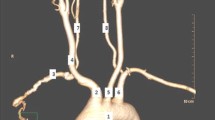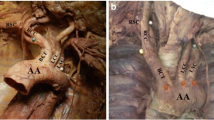Abstract
Background
The variations of vessels arising from the aortic arch are numerous. The purpose of the present study is the description of the aortic arch branches’ variations, in order to offer useful data to anatomists, radiologists, vascular, neck and thorax surgeons. In addition, literature has been reviewed so as to enable a comparison of our results with those of other studies and an analysis of the variations’ clinical implications is possible.
Materials and methods
A total of 633 digital subtraction angiographies of Caucasian Greek patients were examined. No computed tomography or magnetic resonance angiographies were included.
Results
Eight types of the aortic arch were found. The classification from I to VIII was made according to the incidences recorded, with type I being the most and type VIII being the least frequent. Type I, brachiocephalic trunk (BT), left common carotid artery (LCC), left subclavian artery (LS), 527 (83%); type II, BT with LCC and LS, 96 (15%); type III, BT, LCC, left vertebral artery (LV), LS, 5 (0.79%); type IV, right subclavian artery (RS), carotids in common, LS, 1 (0.16%); type V, carotids in common-LS, RS, 1 (0.16%); type VI, carotids and subclavians in common, 1 (0.16%); type VII, RS, right common carotid artery (RCC), LCC, LS, 1 (0.16%); type VIII, BT, thyroidea ima, LCC, LS, 1 (0.16%).
Conclusions
Despite the fact that the variations in question are usually asymptomatic, they may cause dyspnea, dysphagia, intermittent claudication, misinterpretation of radiological examinations and complications during neck and thorax surgery. Furthermore, these variations may be accompanied by other congenital abnormalities.

Similar content being viewed by others
Abbreviations
- BT:
-
Brachiocephalic trunk
- RS:
-
Right subclavian artery
- RCC:
-
Right common carotid artery
- LCC:
-
Left common carotid artery
- LS:
-
Left subclavian artery
- LV:
-
Left vertebral artery
References
Adachi B (1928) Das arteriensystem der Japaner, vol 1. Kenkyusha, Kyoto, pp 29–41
Albayram S, Gailloud P, Wasserman B (2002) Bilateral arch origin of the vertebral arteries. AJNR 23:455–458
Backer CL, Ilbawi MN, Idriss FS, DeLeon SY (1989) Vascular anomalies causing tracheoesophageal compression. Review of experience in children. J Thorac Cardiovasc Surg 97:725–731
Bergman RA, Afifi AK, Miyauchi R (1985–2002) Illustrated encyclopedia of human anatomic variation (online). http://www.vh.org/Providers/Textbooks/AnatomicVariants/Cardiovascular/Text/Arteries/Aorta.html, pp 1–35
Barry A (1951) The aortic arch derivatives in the human adult. Anat Rec 111:221–238
Chadha NK, Chiti-Batelli S (2004) Tracheostomy reveals a rare aberrant right subclavian artery; a case report. BMC Ear Nose Throat Disord 4: 1. http://www.biomedcentral.com/1472-6815/4/1
Demetriades D (2005) An unusual anatomical aortic arch variation. J Trauma 58:654
Ehren H, Wells TR, Landing BH (1985) Association of common origin of the carotid arteries with anomalous origin of the left coronary artery from the pulmonary artery. Pediatr Pathol 4:59–66
Eisenberg R, Vines F, Taylor S (1986) Bifid origin of the left vertebral artery. Radiology 159:429–430
Fazan VPS, Ribeiro RA, Ribeiro JAS, Filho OAR (2000) Right retroesophageal subclavian artery. Acta Cir Bras 18:54–56
Goray BV, Joshi RA, Garg A, Merchanta S, Yadava B, Maheshwariaet M (2005) Aortic arch variation: a unique case with anomalous origin of both vertebral arteries as additional branches of the aortic arch distal to left subclavian artery. AJNR 26:93–95
Grande NR, Costa SA, Pereira AS, Aguas AP (1995) Variations in the anatomical organization of the human aortic arch. A study in a Portuguese population. Bull Assoc Anat (Nancy) 79:19–22
Karkoulias KP, Efremidis GK, Tsiamita MS, Trakada GP, Prodromakis EN, Nousi ED, Spiropoulos KB (2003) Abnormal origin of the left common carotid artery by innominate artery: a case of enlargement mediastinum. Monaldi Arch Chest Dis 59:222–223
Keith A (1895) The modes of origin of the carotid and subclavian arteries from the arch of the aorta in some of the higher primates. J Anat Physiol 29:453–458
Komiyama M, Morikawa T, Nakajima H, Nishikawa M, Yasui T (2001) High incidence of arterial dissection associated with left vertebral artery of aortic origin. Neurol Med Chir (Tokyo) 41:8–12
Krudy GA, Doppman LJ, Brennan FM (1980) The significance of the thyroidea lma artery in arteriographic localization of parathyroid adenomas. Radiology 136:51–55
Lamers LJ, Rowland DG, Seguinn JH, Rosenberg E, Reber K (2004) The effect of common origin of the carotid arteries in neurologic outcome after neonatal ECMO. J Pediatr Surg 39:532–536
Layton KF, Kallmes DF, Cloft HJ, Lindell EP, Cox VS (2006) Bovine aortic arch variant in humans: clarification of a common misnomer. AJNR 27:1541–1542
Liechty JD, Shields TW, Anson BJ (1957) Variations pertaining to the aortic arches and their branches. Q Bull Northwest Univ Med Sch 31:136–143
Lippert H, Pabst R (1985) Arterial variations in man. Classification and frequency. JF Bergmann Verlag, Munich, pp 3–9
Lu J, Ebraheim NA (1999) The vertebral artery: surgical anatomy. Orthopedics 22:1081–1085
Mackay YJ (1888) The development of the branchial arterial arches in birds, with special reference to the origin of the subclavians and carotids. Philos Trans R Soc Lond 179:111–139
Maranillo E, Vazquez T, Quer M, Niedenführ MR, Leon X, Viejo F, Parkin I, Sanudo JR (2008) Potential structures that could be confused with a nonrecurrent inferior laryngeal nerve: an anatomic study. Laryngoscope 118:56–60
McDonald JJ, Anson BJ (1940) Variations in the origin of arteries derived from the aortic arch, in American whites and negroes. Am J Phys Anthropol 27:91–107
Meher R, Sabherwal A, Singh I, Raj A (2004) Dysphagia due a to rare cause. Indian J Surg 66:300
Mok CK, Cheung KL, Kong SM, Ong GB (1979) Translocating the abberant rightsubclavian artery in dysphagia lusoria. Br J Surg 66:113–116
Nayak RS, Pai MM, Prabhu LV, D’Costa S, Shetty P (2006) Anatomical organization of aortic arch variations in the India: embryological basis and review. J Vasc Bras 5:95–100
Nelson ML, Sparks CD (2001) Unusual aortic arch variations: distal origin of common carotid arteries. Clin Anat 14:62–65
Nizankowski C, Rajchel Z, Ziolkowksi M (1975) Abnormal origin of arteries from the aortic arch in man. Folia Morphol (Warsz) 34:109–116
Poultsides AG, Lolis DE, Vasquez J, Drezner AD, Venieratos D (2004) Common origins of carotid and subclavian arterial systems: report of a rare aortic arch variant. Ann Vasc Surg 18:597–600
Thomson A (1893) Third annual report of the Committee of Collective Investigation of the Anatomical Society of Great Britain and Ireland for the year 1891–1892. J Anat Physiol 27:183–194
Tohno S, Tohno Y, Matsumoto H, Fujimoto S, Fujimoto T, Futamura N, Furuta K (1989) A case of the thyroidea ima artery arising from the aortic arch. Kaibogaku Zasshi 64:490–494
Toni R, Della Casa C, Mosca S, Malaguti A, Castorina S, Roti E (2003) Anthropological variations in the anatomy of the human thyroid arteries. Thyroid 13:183–192
Wells TR, Landing BH, Shankle WR (1993) Syndromal associations of common origin of the carotid arteries. Pediatr Pathol 13:203–212
Williams GD, Aff HM, Schmeckebier M, Edmonds HM, Graul EG (1932) Variations in the arrangement of the branches arising from the aortic arch in american whites and negroes. Anat Rec 54:247–251
Author information
Authors and Affiliations
Corresponding author
Rights and permissions
About this article
Cite this article
Natsis, K.I., Tsitouridis, I.A., Didagelos, M.V. et al. Anatomical variations in the branches of the human aortic arch in 633 angiographies: clinical significance and literature review. Surg Radiol Anat 31, 319–323 (2009). https://doi.org/10.1007/s00276-008-0442-2
Received:
Accepted:
Published:
Issue Date:
DOI: https://doi.org/10.1007/s00276-008-0442-2




